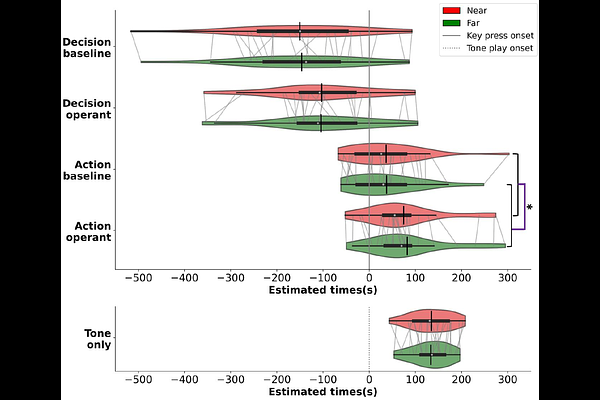Spatial distance and temporal attentional focus modulate voluntary action preparation and awareness

Spatial distance and temporal attentional focus modulate voluntary action preparation and awareness
Kong, G.; Barlerin, B.; Desoche, C.; Miller, L.; Pavani, F.; Farne, A.; Vernet, M.
AbstractPeripersonal space (PPS)-the immediate space surrounding the body-modulates perception and motor control. However, its impact on how voluntary actions are initiated and subjectively experienced remains underexplored. Similarly, how directing attention to different phases of an action, such as intention formation versus execution, and anticipating outcomes of an action, modulates the neural readiness for movement, has yet to be fully examined. This study investigates whether spatial proximity, attentional focus, and anticipated action outcomes influence action preparation and action awareness, using a virtual reality adaptation of the Libet clock paradigm during EEG recordings. Neural results reveal that attentional focus and anticipated action outcomes modulate different phases of motor preparation, as indexed by the readiness potential (RP)-a gradual buildup of neural activity preceding voluntary movement. Focusing on decision timing (without subsequent action outcomes) enhances early RP amplitude and decreases the late RP slope, suggesting increased preparatory neural engagement during intention formation. In contrast, focusing on action execution leads to a steeper late RP slope, indicating later and faster motor activity buildup when attention is directed toward movement onset. Anticipating action outcomes increased late RP slope, which was accompanied by the temporal binding effect: when a tone followed the action, both decision and action estimates shifted toward it. Spatial proximity influences RP dynamics specifically in tasks when participants focused on their intention to act in the absence of an outcome. Behavioural results show that actions are perceived as occurring earlier when the clock is displayed near compared to far, indicating that PPS influences the temporal perception of action timing. Overall, these findings highlight the dynamic interplay among external spatial context and internal cognitive processes in shaping motor preparation and action awareness. Importantly, a temporal internal attentional focus on intention to act modulates early RP-traditionally considered an unconscious stage of neural readiness. These results contribute to a deeper understanding of how PPS and the locus of attention on specific action phases affect action preparation and awareness, with potential implications for future research on the sense of agency and voluntary action decision making.